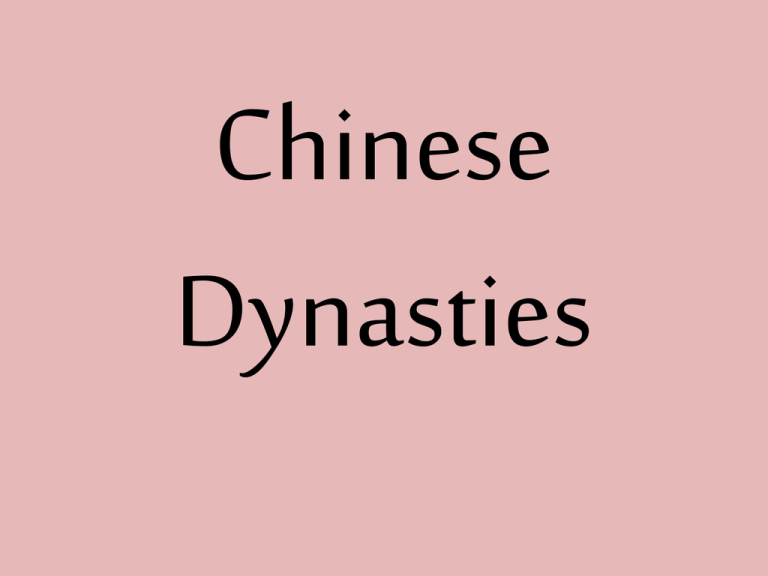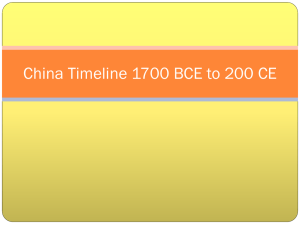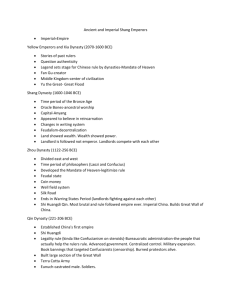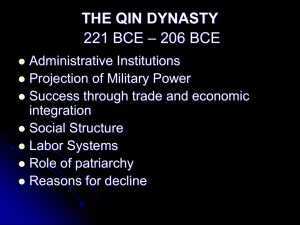Chinese Dynasties
advertisement

Chinese Dynasties SSWH2/C. Describe the development of Chinese civilization under the Zhou, Qin. •The Zhou •Examining the Reign of Qin Shi Huang Di—China’s First Emperor Chinese Dynasties From beginning to end… • • • • • • • • • • • • Shang Dynasty 1766 BCE - 1027 BCE Zhou Dynasty 1122 BCE -256 BCE Qin Dynasty 221 BCE - 206 BCE Han Dynasty 206 BCE - 220AD Sui Dynasty 589 AD - 618 AD Tang Dynasty 618 AD - 907 AD Sung Dynasty 969 AD - 1279 AD Yuan Dynasty 1279 AD - 1368 AD Ming Dynasty 1368 AD - 1644 AD Manchu or Qing Dynasty 1644 AD - 1912 AD 1912 – 1949 Nationalism and Communism 1949 – present Communism Shang Dynasty 1766 BCE - 1027 BCE • • • • First organized river society introduced writing on oracle bones local trade, ancestor worship, bronze age Huang He river The Zhou Dynasty 1122 BCE -256 BCE • Ruled thru the Mandate of Heaven • Dao—”The Way” • Filial Piety—duty of family to “know your place” • Development of Chinese written language • Confucianism and Legalism (more on this later) The Mandate of Heaven The Dynasty rules effectively and efficiently Qin Dynasty 221 BCE - 206 BCE • • • • • • Shi Huang di, unified China using legalism cruel to Confucians Great Wall Terra Cotta army standardized money, weights Built roads and centralized power Qin Shi Huang Di • Zheng (pronounced JUNG) became the king of Qin at age 13 • At age 38—he declared himself “First Emperor” and adopted the name, Qin Shi Huang Di (CHINSHIH-HWONG-DEE) Qin Shi Huang Di and his impact on Chinese Society • Unified laws and currency • Build the infrastructure—road, canals (people were forced into labor) • Began construction of the Great Wall of China Historical Bias? • The story of the Emperor Qin’s life has often been distorted by historical writings • WHY??? The Terra Cotta Army • Qin was terrified of death and wanted to be immortal • Consulted with mystics and drank potions to ensure long life • Died unexpectedly at 49 (work began on his tomb when he was 13) • Tomb: 700,000 workers and covered 8 square miles • Tomb workers were buried alive! (His son didn’t want robbers to find out where is was) The Terra Cotta Warriors Book Burnings and Execution of Scholars • Qin was a legalist and believed people were evil and only strict laws and punishments would make them behave • Confucian Books…banned • Scholars who disobeyed were marked with a facial tattoo and forced into labor • If scholars discussed Confucianism in public..they were killed and had their body put on display Why did the Qin fall? • Failed to rule with humanity • many peasant rebellions, • 3 assassination attempts, • Shi Huangdi’s death, • his son failed as a ruler • lost the Mandate of Heaven Han Dynasty 206 BCE – 220 AD • • • • • • • Classical Age of China inventions (paper) Confucian civil service begins extend Great Wall Silk Road excellent art, public school conquered by Huns Han Dynasty 206 B.C.E.-220 C.E. (c. 400 years) Overview: The Han continued the Q’in organization and empire to build a strong but humane government, great wealth, good Confucian education for upper class men, important inventions and excellent long distance trade. Religion/Philosophy • Confucianism is VERY influential in govt and social life • People follow Confucian morals in all aspects of life • Buddhism came to China via the Silk Road Han Innovations SCIENCE Wrote texts on chemistry, zoology, and botany. Astronomy popular Invented seismograph TECHNOLOGY Paper invented (pic to right) Invented the rudder, fore/aft sails to sail into the wind fishing reels, wheelbarrows, and suspension bridges. MEDICINE Diagnosed diseases. herbal remedies used anesthetics. Acupuncture Han Fall • Han rulers love for wealth and pleasure weakened the government; often corrupt and brutal. • The Han dynasty fell in A.D. 220. – Fiscal crisis (they were broke) – Raised taxes – Peasants get angry – Revolts lead to the downfall of the govt – The Huns attack over the wall – China descends into chaos and warlike states rule for 350 years Comparing…..the Zhou, the Qin and the Han • SSWH2/C. Describe the development of Chinese civilization under the Zhou, Qin (and the Han) • On the left side of your notebook, create a VENN DIAGRAM comparing the three—make sure to include contributions, public works, the way the Emperor Ruled, innovations/technology, etc.







